这个部分是要拓展xv6原来的文件系统,本来的inode是一级的,addrs数组中最后一个元素对应一个间接引用节点的地址,这个节点又包括了256个节点的地址,加上本身的12个节点数据,总共有256+12 = 268个节点,我们要做的就是将这个一级间接引用拓展到二级
![img http://xv6.dgs.zone/tranlate_books/book-riscv-rev1/images/c8/p2.png]()
最开始我没弄清楚具体要怎么实现,再原有基础上直接加成了二级引用的形式,但是对于原本的inode并没有链接上,后来发现需要再原有的addrs数组进行拓展
首先看一下这几个宏,先将 NDIRECT 个直接块减少 1,给二级引用间接块腾出个空间,这样对应 dinode 和 inode 对应的 addrs 数组为了和原本大小保持一致需要加上 1
1
2
3
4
5
6
7
8
9
10
11
12
13
14
15
16
17
18
19
20
21
22
23
24
25
26
27
28
29
30
|
//fs.h
#define NDIRECT 11
#define NINDIRECT (BSIZE / sizeof(uint))
#define DNINDIRECT ((NINDIRECT) * (NINDIRECT))
#define MAXFILE (NDIRECT + NINDIRECT + DNINDIRECT)
struct dinode {
short type; // File type
short major; // Major device number (T_DEVICE only)
short minor; // Minor device number (T_DEVICE only)
short nlink; // Number of links to inode in file system
uint size; // Size of file (bytes)
uint addrs[NDIRECT+2]; // Data block addresses
};
//file.c
struct inode {
uint dev; // Device number
uint inum; // Inode number
int ref; // Reference count
struct sleeplock lock; // protects everything below here
int valid; // inode has been read from disk?
short type; // copy of disk inode
short major;
short minor;
short nlink;
uint size;
uint addrs[NDIRECT+2];
};
|
然后是修改 bmap ,使其能进行二级映射(看懂原本 bmap 应该不难想到)
1
2
3
4
5
6
7
8
9
10
11
12
13
14
15
16
17
18
19
20
21
22
23
24
25
26
27
28
29
30
31
32
33
34
35
36
37
38
39
40
41
42
43
44
45
46
47
48
49
50
51
52
|
static uint
bmap(struct inode *ip, uint bn)
{
uint addr, *a;
struct buf *bp;
if(bn < NDIRECT){
if((addr = ip->addrs[bn]) == 0)
ip->addrs[bn] = addr = balloc(ip->dev);
return addr;
}
bn -= NDIRECT;
if(bn < NINDIRECT){
// Load indirect block, allocating if necessary.
if((addr = ip->addrs[NDIRECT]) == 0)
ip->addrs[NDIRECT] = addr = balloc(ip->dev);
bp = bread(ip->dev, addr);
a = (uint*)bp->data;
if((addr = a[bn]) == 0){
a[bn] = addr = balloc(ip->dev);
log_write(bp);
}
brelse(bp);
return addr;
}
bn -= NINDIRECT;
if(bn < NINDIRECT * NINDIRECT){
// Load indirect block, allocating if necessary.
if((addr = ip->addrs[NDIRECT + 1]) == 0)
ip->addrs[NDIRECT + 1] = addr = balloc(ip->dev);
bp = bread(ip->dev, addr);
a = (uint*)bp->data;
if((addr = a[bn / NINDIRECT]) == 0){
a[bn / NINDIRECT] = addr = balloc(ip->dev);
log_write(bp);
}
brelse(bp);
bp = bread(ip->dev, addr);
a = (uint*)bp->data;
if((addr = a[bn % NINDIRECT]) == 0){
a[bn % NINDIRECT] = addr = balloc(ip->dev);
log_write(bp);
}
brelse(bp);
return addr;
}
panic("bmap: out of range");
}
|
以及将 itrunc 中对应的二级间接块也进行删除
1
2
3
4
5
6
7
8
9
10
11
12
13
14
15
16
17
18
19
20
21
22
23
24
25
26
27
28
29
30
31
32
33
34
35
36
37
38
39
40
41
42
43
44
45
46
47
48
49
50
51
52
53
|
// Truncate inode (discard contents).
// Caller must hold ip->lock.
void
itrunc(struct inode *ip)
{
int i, j, k;
struct buf *bp, *nbp;
uint *a, *na;
for(i = 0; i < NDIRECT; i++){
if(ip->addrs[i]){
bfree(ip->dev, ip->addrs[i]);
ip->addrs[i] = 0;
}
}
if(ip->addrs[NDIRECT]){
bp = bread(ip->dev, ip->addrs[NDIRECT]);
a = (uint*)bp->data;
for(j = 0; j < NINDIRECT; j++){
if(a[j])
bfree(ip->dev, a[j]);
}
brelse(bp);
bfree(ip->dev, ip->addrs[NDIRECT]);
ip->addrs[NDIRECT] = 0;
}
if(ip->addrs[NDIRECT + 1]){
bp = bread(ip->dev, ip->addrs[NDIRECT + 1]);
a = (uint*)bp->data;
for(j = 0; j < NDIRECT; j++){
if(a[j]) {
nbp = bread(ip->dev, a[j]);
na = (uint*)nbp->data;
for(k = 0; k < NDIRECT; k++){
if(na[k]) {
bfree(ip->dev, na[k]);
}
}
brelse(nbp);
bfree(ip->dev, a[j]);
a[j] = 0;
}
}
brelse(bp);
bfree(ip->dev, ip->addrs[NDIRECT + 1]);
ip->addrs[NDIRECT + 1] = 0;
}
ip->size = 0;
iupdate(ip);
}
|
这部分是为xv6添加系统调用 symlink,也就是符号链接
头文件什么的这里就不赘述了,先前也做过好几次,这里主要是系统调用 sys_symlink 的实现以及 sys_open 的修改,最开始我理解的是 symlink 打开一个符号链接文件然后将内容写入到文件 inode 的信息中,后来发现这是创建一个符号链接文件而不是打开一个文件!另外就是我把数据存放在 inode 的 addrs 数组中是直接通过 (char*) 强制类型转换的。。。参考了别人的文章发现这个大问题,原来是有相关的函数将数据写入 inode 中的,还是要好好看一下 xv6 book
代码就不贴了,内容和下面参考资料大差不差
参考资料:
完结证明:
![https://silas-py-oss.oss-cn-chengdu.aliyuncs.com/img/20220730173226.png https://silas-py-oss.oss-cn-chengdu.aliyuncs.com/img/20220730173226.png]()
我发现我好几次测试都会超时,不知道是不是虚拟机的问题,跑的太慢了,在qemu中测试的时候都可以通过,但是就会超时,只能改测试代码的时间限制了……

